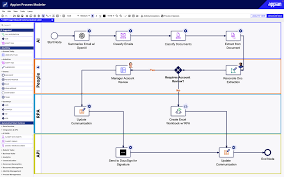When searching for a business process automation solution, Appian often tops the list of potential platforms. While it is a popular choice, it is not always the best fit for every company. With other platforms offering different strengths—like ease of use, pricing, and flexibility—it makes sense to explore Appian alternatives to find what works best for your needs.
What is Appian?
Appian is a low-code automation platform designed to help businesses streamline workflows, automate tasks, and develop custom applications quickly. It enables organizations to digitize their processes with minimal coding, making it a popular choice for companies looking to enhance operational efficiency. With features like process automation, case management, and integration with enterprise systems, Appian supports complex business needs across various industries.
Why You Should Look for Appian Alternatives
Appian is a well-known player in the low-code automation space and is known for its capability to help businesses streamline workflows and develop applications quickly. But it’s not without its challenges. The three main challenges Appian users report are:
- Steep Learning curve: Despite its capabilities, Appian's complex interface presents significant challenges for non-technical users, often requiring extensive training.
- Premium Pricing: Appian's enterprise-focused pricing structure can be prohibitive, particularly for small- to medium-sized businesses with limited budgets.
- Customization Constraints: While Appian offers customization options, its pre-built processes can be rigid and complex to modify, limiting adaptability for unique business requirements.
If these issues are a pain point for your business, then it’s time to start considering alternative platforms with similar capabilities, intuitive interfaces, better pricing, and more tailored solutions.
Top 10 Appian Alternatives for Business Automation
Now that we’ve covered why you might be searching for an alternative, let’s dive into the top competitors of Appian in 2025 that you should know of:
|
Feature |
Appian |
FlowForma |
Kissflow |
Nintex |
Power Automate |
Ninox |
|
Type |
Low-code |
No-code |
low-code |
low-code |
low-code |
low-code |
|
Ease of Use |
Steep Learning Curve |
User Friendly |
User Friendly |
Moderate |
Complex |
User Friendly |
|
Integrations |
Extensive |
Ideal with Microsoft |
Ideal with Google Workspace |
Works well with Microsoft |
Works well with Microsoft |
Ideal with Google Workspace |
|
Customization |
Highly customizable |
Great for general and complex processes |
Moderate customizations allowed |
Customizable workflows |
Customizable workflows |
Customizable workflows |
|
Deployment Time |
Several weeks to months |
Quick deployment |
Quick deployment |
Moderate |
Depending on the complexity |
Fast, with minimal setup |
|
Pricing |
High cost |
Affordable with flexible pricing |
Starts at $9 per user/month |
Custom pricing |
Starts at $15 per user/month |
Starts at $10 per user/month |
1. FlowForma

FlowForma leads the no-code process automation platform, empowering both business users and IT teams to digitize workflows easily. It stands out for its ease of use, flexible pricing, and comprehensive AI-powered feature set. Whether you're working in healthcare, construction, or finance, FlowForma provides the tools you need to automate processes quickly and efficiently without any coding expertise.
FlowForma Key Features
- No-code platform: Anyone in your organization can build and automate workflows—no coding required.
- AI-powered: Copilot and AI summarization features driving workflow efficiency.
- Highly customizable workflows: Industry-specific templates help you tailor processes to your exact needs.
- Seamless integration: FlowForma integrates effortlessly with tools like Microsoft SharePoint and Office 365.
- Real-time analytics: Get deep insights into how your processes are performing.
FlowForma Pros
- Easy to use, especially for non-technical users
- Flexible pricing structure, ideal for small to large businesses
- Extensive integration options with Microsoft tools
- Quick to deploy, with users becoming self-sufficient in just weeks
FlowForma Cons
- Designed for organizations with more compex business processes
- Less options for advanced coders looking to code processes from the ground up
FlowForma Pricing
FlowForma offers three pricing plans:

Automation that is powerful, intuitive, and effective.
Discover how Coinford, a leading construction firm, enhanced efficiency, transparency, and control by digitizing its processes with FlowForma. See firsthand how this platform can empower your business to streamline operations without heavy IT investment.
Read the full case study here.
2. Kissflow
Kissflow is a versatile platform offering both low-code and no-code capabilities, making it accessible for businesses of all sizes. Designed to help teams automate their workflows, manage tasks, and streamline processes, Kissflow empowers users to create their own applications with minimal technical expertise.
Kissflow Key Features
- Dual Development Approach: Choose between low-code development for complex processes or intuitive drag-and-drop interfaces for simple workflows.
- Complete Process Management: Streamline everything from basic workflows to complex case management scenarios.
- Built-in Collaboration Tools: Track progress, manage approvals, and facilitate team communication seamlessly.
- Extensive Integration Hub: Connect with essential business tools including Google Workspace, Slack, and Dropbox.
Kissflow Pros
- Simple and easy to use, even for non-technical users
- Offers both low-code and no-code options, providing flexibility based on your needs
- Strong focus on collaboration and team visibility
- Quick deployment and setup
Kissflow Cons
- Limited advanced features for complex enterprise-grade applications
- Customization options are not as extensive as some competitors
Kissflow Pricing
Kissflow's basic pricing plan starts at $1,500/month for up to 50 users. Custom pricing for the enterprise plan is available for larger organizations. Contact Kissflow’s team for more details.

3. Nintex

Nintex is a widely used process management and automation platform that focuses on providing businesses with tools to automate repetitive tasks, manage documents, and improve workflow efficiency.
Nintex Key Features
- Process automation: Nintex automates business processes such as document management, approvals, and compliance workflows, reducing manual tasks and errors.
- Document generation: Easily create and manage documents with automatic data population and advanced reporting capabilities.
- Workflow management: Create workflows that are customizable to fit your business needs, including conditional logic and triggers.
- Integration capabilities: Nintex supports integrations with systems such as SharePoint, Office 365, and Salesforce, ensuring that your workflows connect seamlessly across platforms.
Nintex Pros
- Strong document generation and automation features
- Extensive integration options with enterprise software
- Ideal for automating repetitive tasks and improving efficiency in large organizations
- Good for managing complex workflows with conditional logic
Nintex Cons
- Pricing can be on the higher side for small businesses.
- The user interface can be overwhelming for first-time users, requiring some onboarding time.
Nintex Pricing
Nintex offers a premium and custom plan. Contact the sales team for more information.

4. Power Automate

Power Automate is a part of Microsoft’s Power Platform that comes with a suite of powerful tools to help businesses automate their processes. It allows businesses to build custom applications, automate workflows, and gain insights through data analytics, making it a robust alternative to Appian. With deep integration into the Microsoft ecosystem, it’s a natural fit for businesses already using tools like Microsoft 365, SharePoint, and Azure.
Power Automate Key Features
- Workflow Automation: Power Automate enables businesses to automate repetitive tasks, approvals, and workflows without the need for extensive coding. It allows for the creation of multi-step workflows across different applications and services.
- Integration with Microsoft Services: It offers deep integration with the Microsoft ecosystem, including Office 365, SharePoint, Teams, Azure, and Dynamics 365, making it ideal for organizations that already utilize Microsoft tools.
- Connectors and Integration Capabilities: Power Automate has hundreds of pre-built connectors for various applications and services, including third-party tools, which allow for seamless data transfer and workflow integration.
- Robotic Process Automation (RPA): It includes RPA capabilities to automate manual and legacy tasks through attended and unattended bots, enhancing productivity across both digital and physical environments.
Power Automate Pros
- Deep integration with other Microsoft tools, making it ideal for organizations already using Microsoft services
- Wide range of functionality across app development, automation, and data analysis
- Strong scalability, suitable for both small businesses and large enterprises
- Customizable workflows that can be tailored to business needs with minimal coding
Power Automate Cons
- Pricing can become expensive as you add more features and users.
- Non-Microsoft integrations can be limited and more challenging to set up.
- Some users find the interface complex, especially for first-time users.
Power Automate Pricing
Power Automate offers 2 paid plans.

5. Ninox

Ninox is a low-code platform designed for businesses looking to create custom databases and workflows. Its intuitive design makes it easy for users to build applications without technical expertise, offering solutions for project management, CRM, and data tracking. Ninox is a more budget-friendly alternative to Appian, especially for smaller businesses looking for a simple and effective way to automate workflows.
Ninox Key Features
- Custom database creation: Build custom databases to manage business operations, from CRM to inventory tracking, without the need for advanced technical skills.
- Collaboration features: Teams can collaborate on workflows in real-time, ensuring visibility and smooth task management.
- Cross-platform support: Ninox works across multiple devices, including desktop, mobile, and tablets, ensuring flexibility and accessibility.
- Integration: Integrates with popular apps like Zapier, Google Calendar, and Mailchimp for streamlined workflows.
Ninox Pros
- Affordable and simple to use, making it ideal for small to medium-sized businesses
- Strong cross-platform support for greater flexibility
- Customizable workflows with a minimal learning curve
Ninox Cons
- Limited scalability for large enterprises
- Lacks advanced features found in more comprehensive platforms like Appian
Ninox Pricing
Ninox offers 3 paid plans

6. OutSystems

OutSystems is a high-performance, full-stack low-code platform designed for developing and deploying applications at speed. It is widely regarded as a robust alternative to Appian, particularly for businesses looking to build complex applications with a rich user experience. OutSystems allows developers to create applications with minimal coding while maintaining the flexibility to address intricate business challenges.
OutSystems Key Features
- Full-stack development: Offers both front-end and back-end capabilities for creating complex applications
- Customizable templates: A large library of templates and reusable components to speed up app development
- Cloud-native deployment: Supports cloud, on-premise, or hybrid deployment models for flexibility in infrastructure
- Collaboration tools: Provides tools for teams to collaborate efficiently across the app development lifecycle
OutSystems Pros
- Ideal for building complex, enterprise-level applications
- Scalable and flexible across different deployment environments
- Extensive support for integrations and API usage
OutSystems Cons
- Steeper learning curve compared to some other low-code platforms
- Higher cost, especially for small and medium-sized businesses
OutSystems Pricing
OutSystems offers 2 pricing plans.

7. Pipefy

Pipefy is a process management and automation tool that focuses on optimizing workflows and simplifying project management. It offers pre-built templates and customizable workflows, making it an attractive alternative to Appian for businesses that need a lightweight, easy-to-use solution.
Pipefy Key Features
- Workflow automation: Automates routine processes with minimal setup, such as approvals, invoicing, and hiring
- Template library: Offers a wide variety of templates to help users quickly build workflows
- Kanban-style task management: Visualize tasks and workflows using a Kanban board layout for easier management
- Integrations: Supports integrations with tools like Slack, Trello, and Google Workspace for seamless operations
Pipefy Pros
- Easy to use, with a low learning curve
- Great for task and project management with visual workflows
- Affordable, making it accessible for small businesses
Pipefy Cons
- Limited customization options for complex workflows
- Not as robust for large-scale enterprise automation needs
Pipefy Pricing
Pipefy offers 3 paid plans with no publicly available pricing. Contact their sales team for more details.

8. Creatio

Creatio is a low-code platform that combines process automation and CRM capabilities, making it an all-in-one solution for businesses that need both workflow management and customer relationship management. It’s a versatile alternative to Appian for businesses in the sales, marketing, and service industries.
Creatio Key Features
- Unified CRM and BPM: Offers built-in CRM capabilities alongside business process management (BPM) tools
- Low-code platform: Allows users to design and automate workflows with minimal coding expertise
- AI-driven analytics: Provides real-time insights and analytics powered by AI to optimize decision-making
- Customization and scalability: Highly customizable workflows that can scale to fit the needs of both small and large enterprises
Creatio Pros
- Excellent combination of CRM and process automation in one platform
- AI-powered analytics for better decision-making
- Highly customizable and scalable for growing businesses
Creatio Cons
- Pricing can be high for small businesses.
- The learning curve can be steep for non-technical users.
Creatio Pricing
Creatio offers 3 paid models based on the following structure.

9. ProcessMaker

ProcessMaker is an open-source process management and workflow automation platform known for its flexibility and cost-effectiveness. It is a strong alternative to Appian, especially for companies that prefer open-source solutions for customizing their business processes.
ProcessMaker Key Features
- Workflow automation: Automates business processes such as approvals, document management, and data collection
- BPMN 2.0 support: Offers drag-and-drop process modeling using BPMN 2.0 standards
- Open-source platform: Provides flexibility for developers to modify and customize the platform to suit their needs
- Integration capabilities: Easily integrates with existing systems, such as ERP and CRM platforms, through APIs
ProcessMaker Pros
- Open-source nature allows for high customization and flexibility.
- Affordable and ideal for businesses with technical resources
- Strong process modeling capabilities with BPMN 2.0 compliance
ProcessMaker Cons
- Requires more technical expertise for setup and customization
- Not as user-friendly for non-technical teams compared to no-code solutions
ProcessMaker Pricing
ProcessMaker pricing is not publicly available, but there are 3 plans available.

10. Pega Platform

Pega Platform is an enterprise-grade automation platform known for its AI-powered decision-making capabilities and robust workflow automation. It’s designed for large organizations looking to scale their operations while incorporating advanced features like robotic process automation (RPA) and customer engagement tools. Pega is a strong competitor to Appian, especially for companies focused on customer service and operational efficiency.
Pega Platform Key Features
- AI-powered automation: Uses AI to optimize workflows and make real-time decisions
- Robotic process automation (RPA): Automates repetitive tasks with bots, improving efficiency across operations
- Case management: Manages complex cases and workflows, ideal for industries like finance and healthcare
- Customer engagement: Provides tools for improving customer experiences through omnichannel engagement and personalization
Pega Platform Pros
- Excellent for large-scale automation projects, especially those needing RPA
- AI-driven decision-making helps optimize workflows.
- Ideal for industries requiring complex case management and customer engagement
Pega Platform Cons
- Higher cost, making it less accessible for small businesses
- Steep learning curve and requires significant onboarding for non-technical users
Pega Platform Pricing
Pricing for PegaPlatform is not publicly available. Contact their sales team for more information.

Why is FlowForma a Natural Appian Alternative for your Business?
FlowForma addresses key enterprise pain points in Appian's offering while delivering additional strategic advantages:
- Ease of Use: One of the primary strengths of FlowForma is its no-code platform. Unlike Appian, which can have a steep learning curve for non-developers, FlowForma is designed to be intuitive and user-friendly.
- Flexible Pricing: Pricing can be a dealbreaker for many businesses considering Appian. FlowForma stands out with its more transparent and scalable pricing structure. This flexibility makes it accessible to companies of all sizes, from small businesses to large enterprises.
- Customization Options: Whether your business operates in healthcare, construction, or finance, FlowForma offers a range of customizable templates and workflow solutions to meet industry-specific needs
- Seamless Integration: FlowForma integrates smoothly with popular tools such as Microsoft SharePoint and Office 365. This ensures that your workflows are connected to your existing systems, helping teams work more efficiently by using the platforms they are already familiar with.
- Advanced AI-powered features: FlowForma has developed new AI-powered Copilot and summarization features which drive faster productivity improvements compared with Appian.
For businesses seeking a cost-effective, easy-to-use, and highly customizable alternative to Appian, FlowForma is the ideal choice. With its no-code platform, flexible pricing, and broad customization capabilities, FlowForma helps organizations digitize processes quickly and with minimal technical overhead.
Key Takeaways
While Appian remains a significant player in enterprise process automation, 2025's market demands greater agility and cost-effectiveness. FlowForma leads the new generation of automation platforms by combining enterprise-grade capabilities with unprecedented ease of use and rapid deployment options.
If you're ready to take the next step, start your free trial or book a demo with FlowForma today!
FAQs
1. What are the key considerations when migrating from Appian to an alternative platform?
Migrating from Appian to another platform requires a few essential considerations:
- Ease of Implementation: Choose a platform that offers a smooth, quick deployment process to minimize downtime. FlowForma, for instance, excels in rapid deployment, allowing teams to become self-sufficient within weeks.
- Customization Capabilities: If your business relies on specific workflows, select a platform like FlowForma, which offers industry-specific templates and highly customizable workflows to adapt to your unique requirements.
- Cost Efficiency: Evaluate the pricing models of alternative platforms to ensure they align with your budget, especially if Appian’s pricing has been a limitation.
FlowForma’s transparent and scalable pricing makes it accessible for businesses of all sizes, delivering excellent value without compromising on features.
2. What integration capabilities should enterprises evaluate when choosing an Appian alternative?
A strong integration framework is critical for seamless workflows. Consider the following:
- Compatibility with Existing Tools: A platform should integrate effortlessly with your existing software to support workflow efficiency. FlowForma, for example, integrates smoothly with Microsoft tools like SharePoint and Office 365, making it a natural fit for organizations that already use these systems.
- Third-Party Compatibility: If your business relies on other applications, check for pre-built connectors or API compatibility. FlowForma offers extensive integration options, helping you connect your workflows across different platforms without technical hassles.
3. What security and compliance considerations should influence platform selection?
The security and compliance considerations that should be considered while selecting a platform are as follows:
- Data Security: Ensure that the platform meets your organization’s data security requirements, with features like encryption, role-based access, and multi-factor authentication.
- Compliance Standards: Look for a platform that aligns with regulatory standards relevant to your industry, such as the GDPR, HIPAA, or SOC2. FlowForma is built with robust security protocols, enabling organizations in regulated sectors like healthcare and finance to meet compliance needs confidently.
- Audit Trails: Platforms like FlowForma provide real-time insights and comprehensive audit trails, ensuring you can track activities and comply with industry regulations efficiently.
 By
By 




